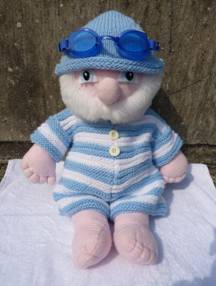
Salty Sam’s Fun Blog for Children
Number 226
The lnternational Dateline
Hello Everyone

When you are a sailor, like l used to be, you can spend many weeks at sea. There is nothing to look at beyond the ship except the waves stretching away to the horizon.
ln order to not get bored, you have to find ways to pass your time.
Besides doing things like eating, reading and playing games, sailors have invented their own pastimes and entertainments to keep themselves amused.
One of the strange traditions that sailors have, is a ceremony they perform when they cross the Equator or lnternational Dateline. There is a lot of dressing up and usually someone dresses up as King Neptune – Legendary King of the Sea.
You might not know what the lnternational Dateline is – so l will explain it to you…
A long time ago, on Blog Post 75 in fact, l explained to you how at any one time, in different parts of the world, different times will be showing on a clock there.
l told you that when it is breakfast time in New York, it is lunchtime in London, teatime in Moscow, dinnertime in China and bedtime in Tokyo, Japan. ln Wellington, in New Zealand, most people are asleep.
ln very large countries, like The United States, Canada and Russia, there are many time zones reaching across from east to west.
The Greenwich Meridian is an invisible line that runs straight down from the top of the world to the bottom through Greenwich in London.
lt is at this line that the Western Hemisphere meets the Eastern Hemisphere. A hemisphere is half a globe. Of course the world is the shape of a ball – or globe.
There is also an invisible line called the Equator which runs around the centre of the globe and divides the world into north and south.
The Greenwich Meridian is at the centre of world time. This time is called Greenwich Mean Time (GMT). ln the summer the United Kingdom goes over to British Summer Time (BST) but operates on Greenwich Mean Time during the winter months.
Hundreds of thousands of people visit Greenwich every year where they can stand astride a line at the Royal Observatory at the top of the hill – and stand in the east and west of the world at the same time.
This line can also be called the Prime Meridian or zero degrees longitude. lt was established in Greenwich in 1852 as the world’s time standard. The world wide standard for coordinating time is now sometimes called UTC instead of GMT.
ln the 19th century, the more travelling to far off places was becoming common place, the more sailors and cartographers (people who draw maps) wanted to bring order to the world’s surface. They wanted to measure it and chart it so that travellers could find their way around more easily.
The Greenwich Meridian line is also marked in hundreds of other places too down the globe. The line passes from the North Pole to the South Pole through France, Spain, Algeria, Mali, Burkina Faso, Togo, Ghana and Antarctica.
Can you find these places on a map?
But at the opposite side of the world, something very different is happening.
There is another invisible line at the other side of the world and this one is called the lnternational Date Line. lt was established in 1884.
lt passes through the middle of the Pacific Ocean and is about 180 degrees longitude.
lt is at this line that the date changes. The line separates two consecutive calendar days. West of it is one date and east of it is another date.
But the line has no legal status on land, and countries are free to set their own dates.
Because of this, the lnternational Date Line zigzags about all over the place – between islands and borders of countries. This is so countries and regions are not divided by it.
lt has been moved over the years to accommodate the wishes of the people who live in the area. lt was moved, for example, at the beginning of the millennium because some people wanted to be amongst the first to greet the twenty-first century rather than amongst the last!
To the left of the dateline the date is always one day ahead of the date immediately to the right – or to the east of the line; which is actually the Western Hemisphere because it is west of Greenwich.
lt might seem strange, but it is possible to stand on one island and look over a stretch of sea to another island nearby which has the same time on its clocks but a different date on its calendar!
For example, Tonga and American Samoa have the same time but are one day apart.
But time variations across the line are not always exactly 24 hours because of times that are set locally.
The first major cities to get a new date are in New Zealand.
Ships are supposed to adopt the time of a country if they are within its territorial waters (which are within 22km or 12 nautical miles of land).
They use international time zones when they are in international waters.
To cross the lnternational Date Line when you are on a ship can be quite an occasion. The captain might announce it to the passengers or there might even be a celebration or ceremony. This happens too when a ship crosses the Equator.
lf you travel around the world, you change your watch by an hour for every new time zone you enter.
lf you travel east across the lnternational Date Line, you will travel back to the date before and if you travel west across the lnternational Date Line you travel to the next calendar day. This might be the nearest you will ever get to time travel without owning a TARDlS!
Bye bye everyone – don’t forget to subscribe to my blog!
lf you like my blog, please support it by telling all your friends and followers about it.
Thank you!
And see you again next Fun Friday!
Love and kisses
Salty Sam

www.christina-sinclair.com


Bill and Bob’s Joke of the Week![]()
![]()
Bob: Why did the girl tear a page off the calendar?
Bill: l don’t know. Why did the girl tear a page off the calendar?
Bob: Because she wanted to have the month off!

Salty Sam © Christina Sinclair 2015
Unauthorized use and/or duplication of material from this blog without express and written permission from this blog’s author and owner is strictly prohibited.
Links may be used to www.christina-sinclair.com

Picture Gallery
 When ships started to travel across great oceans they needed methods of navigation
When ships started to travel across great oceans they needed methods of navigation
 The International Dateline
The International Dateline
 The International Dateline
The International Dateline
 The Meridian at Greenwich
The Meridian at Greenwich
 It has countries marked along it and tourists try to find their own
It has countries marked along it and tourists try to find their own
 A depiction of King Neptune
A depiction of King Neptune


 THE SALTY SAM NEWS DESK
THE SALTY SAM NEWS DESK

It is at this time of year you will see lots of very large daisies growing in patches of long grass. They have lovely, happy faces and are very pretty flowers to see along the roadsides.
These daisies are called ox eye daisies.
But there are lots of kinds of large daisies that grow in gardens too.

Last year Bill, Bob, Emily and Henry collected lots of wild flower seed from the orchard behind Auntie Alice’s garden and then distributed them along the sides of the lane that runs between Bill and Bob’s back gate and Emily’s back gate.

Honeysuckle in a the hedgerow
(Honeysuckle smells very sweet)
And now they are seeing the fruits of their labours.
In fact, the other neighbours have commented on how pretty the edges of the lane look this year and when Henry comes round to Bill and Bob’s house to play, he can see how much the bees and other pollinating insects are enjoying the flowers there too.

A bee on cow parsley
If you want to plant some flowers to help the bees, they really like clover, lavender and snapdragons.

Clover lives happily in grass, lavender makes a lovely scented hedge or a nice bush to have in a low maintenance garden and snapdragons are really colourful flowers to put in your garden borders or pots.
Snapdragons are usually grown as annuals but if you are lucky can self-seed.
They come in many different soft pastel colours.
They also come in different heights so that you can choose which is better for your garden.
They are easy to grow but might prefer partial shade if you have a very hot sunny garden. They like to be watered in a hot summer.
Once the bees find your flowers they will go back to the hive and tell the other bees how to find them too.
The bees will be able to navigate themselves to the places where they can find nectar and pollen.
Bees are very clever!

Snapdragons

*********************
TO ADVERTISE ON THIS BLOG
PLEASE CONTACT:
christina.sinclair.ads@aol.co.uk
*********************


Quick Quiz
And here is another column word puzzle for you to do.
Draw a column of boxes – it should be three boxes across and thirteen boxes down.
Answer the questions and put one letter in each box.
Read down the first column to find a way to cross the lnternational Dateline.
- the opposite to even
- a little bite
- a playing card with the number one on it
- to slice
- a bone around your chest
- what Bill and Bob sometimes call me for short
- frozen water
- a male child
- one of the largest species in the deer family
- tiny mouthful of liquid
- a long handled box for carrying bricks
- unwell
- small sharp tool for holding fabric together found in a sewing box




lt’s the Weekend!

HOW TO MAKE SOME TWELVE lNCH DOLL SHOULDER BAGS
On Blog Post 149 there were some bags to make using knitting yarn.
You can use rectangles of felt and decorate with embroidery or beads to make bags too.
You could use lengths of very narrow ribbon to make straps or lengths of yarn.
The white bag is made from a rectangle of felt with a flower embroidered into one corner. The sides are then sewn up and the strap is added.
The pink and red bags are made from two rectangles 5cm by 3cm with the end shaped into a curve. Making the curved end into the bottom or the flap makes two different shaped bags.
Sew the bead or any other decoration you choose to use onto one of the sides before you construct the bag.

Please note that the material on this blog is for personal use and for use in classrooms only.
It is a copyright infringement and, therefore, illegal under international law to sell items made with these patterns.
Use of the toys and projects is at your own risk.
©Christina Sinclair Designs 2015


Quick Quiz Answers
- ODD
- NlP
- ACE
- CUT
- RlB
- UNC
- lCE
- SON
- ELK
- SlP
- HOD
- lLL
- PlN
ON A CRUlSE SHlP


For an Embroidery Stitches Chart
Check out Blog Post 3



